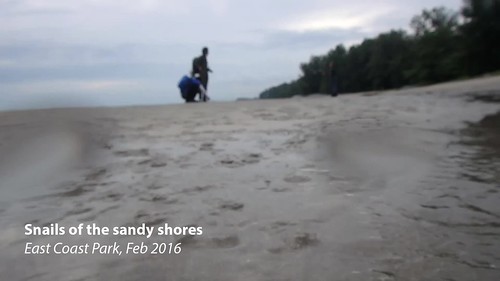A small team made a spur-of-the-moment decision to check it out yesterday, despite the not-so-low-tide. And we found sea stars, special snails and other surprises.
The sandy shores are teeming with tiny to small Cake sand dollars. There were several families on the shore and the kids found all kinds of interesting marine life.
These included baby Knobbly sea star and a Cake sea star that was eating a dead fish! They also found a Peachia anemone that was out of the sand and looked strange to them. I did not see any buried sea cucumbers. Kok Sheng found even more interesting sea stars and marine life.
Another special find were several small Thick-edged sand dollars.
There were also lots of living Button snails on the shore! A lot more than on our last trip here in the morning in Jul 2015.
Button snails are preyed upon by all kinds of burrowing animals. You can often see signs of this on the sand, with trails of panicky button snails moving away from a large tunneling burrower.
Here's a video of some of the burrowing predators that we saw on this shore. These include the Fig snail, Ball moon snail, Lined moon snail, Naked moon snail, Weasel olive snail and Grey bonnet snail.
I also saw snails buried in the sand that are ordinarily seen above the sand. Like the Spiral melongena and the Gong gong snail. The Lined moon snail in the photo is a burrower.
The tide was too high to check on the seagrasses which we first saw growing here in Jun 2015. But I did get a glimpse of some growing nearer the high shore. There were lush growths of broad Needle seagrass and Spoon seagrass with large leaf blades. I also saw one Haddon's carpet anemone. This video clip shows how the tiny seagrasses hold up in the surging waves.
Oh dear, some of the rocks on the artificial shore were turned over. This will cause the animals that have grown on the rock to die as they are exposed to light and dry out during low tide. Remember to turn back all rocks gently after you have a look at what is under them. There was one person far out at sea possibly fishing. I didn't come across any nets or traps on the shore.
Let's hope the shore continues to prosper and grow richer until our next survey.
Posts by others on this trip
- Loh Kok Sheng on facebook and his blog.
- Jonathan Tan on facebook.










